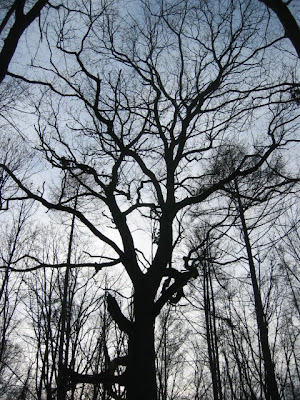
LAS BIELANSKI: THE BRAIN OF BIELANY
The history of the living world can be summarized as the elaboration of ever more perfect eyes within a cosmos in which there is always something more to be seen.
Pierre Teilhard de Chardin, The Phenomenon of Man.
Warsaw is a city of small forests. There are some dozen 'rezerwat' and 'lasek' within the city's relatively compact limits. Warsaw is a city surrounded by forests too. On the city's periphery, covering Warsaw on all four sides, are the larger 'las' of Kabaty and Mlociny, and National and Landscape Parks of Kampinos and Mazovia.
One such forest, both a 'rezerwat' (protected area) and 'lasek' (small forest) is a fragmentary remnant of the great primeval forest of Mazovia, Las Bielanski. Lying on the west bank of the Vistula at the northern perimeter of Warsaw, a mere ten minutes by metro from the centre of Warsaw (you try doing that in London), Las Bielanski is a wondrous forest of old and young growth trees. It is here, unlike any park or topiarised woodland, that you can get a sense of the symbiotic cycles of life and death that an unmanaged forest is made up of. Comprising some 152 hectares, and bounded in by three hulking expressways you're never very far from 'civilisation', yet within these forest boundaries there is an unmistakeable sense of the primordial. This is a place where time sings. The forest itself is but a meandering echo of the great forest that once covered all of Europe.
Woodpeckers tear away on the rotting bark of dying trees, deer make their home here, wild lynx and moose have even strayed down from the much larger Kampinos several kilometres to the north-west. In a clearing at the forest’s eastern edge, perched on the escarpment overlooking the river (and expressway), is the site of the 17th century Cameldolite Monastery, now part of the University grounds here. It was the Cameldolites who gave Bielany her name both here and in Krakow, 'bielany' referring to their white robes.
As far as trees are concerned, Las Bielanski is full of oak, alder, ash, pine, birch and lime. There are hazel and hornbeam, rowan, juniper and buckthorn. Fossil leaves and pollen show that the oaks, the oldest of the lot, have been here for at least a million years, but have come and gone in the warm interglacial periods. The Scots pine, with its eco-plasticity and its high adaptability, is also dominant here, especially fond of the sandy subsoil that so much of this area is made of. There are parts of the forest, with the extreme old age of some of the trees, whether pine, oak or other, and with a forest floor strewn with hollowed out trunks, that resemble the age old Bialowieza Puszcza (primeval forest) on the Polish Belarusian border. The forest, though more visibly full of death than life, especially in the midst of winter, is in-visibly replete with activity.
What makes the likes of Las Bielanski different from ‘normal’ forests is its untended nature. It is left to its own devices, its own world lives and breathes, regulates itself without too much human interference. It is of its own mind so to speak. It is perhaps incomparable to the great and pristine puszcza of Bialowieza. Nevertheless, here, in the depths of Las Bielanski, there is a similar intelligence at work.

When I look at the canopy of a forest in winter each tree appears like a neuron extending and feeling into space. Their structure and 'behaviour' are almost identical, albeit on a different scale. Together, these trees, as the forest, form a cortex (the word 'cortex' comes from the Latin meaning 'bark'). And, as anyone reading this should be able to tell you, if you connect enough cortices together, you've got yourself a real living brain.

The Brain of Bielany.










No comments:
Post a Comment